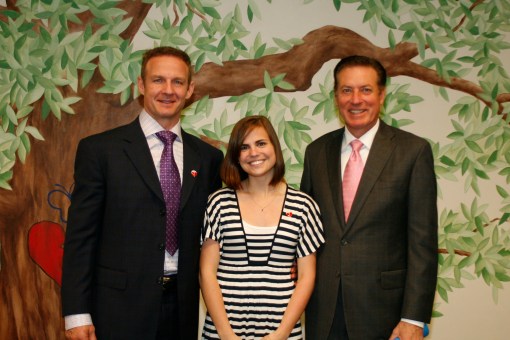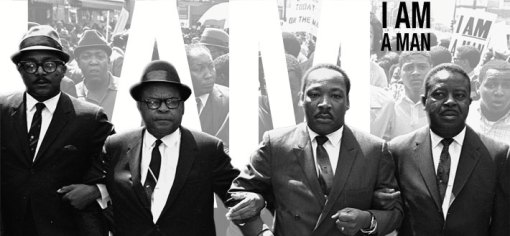I am a very social person, so when I was given the task of interviewing nonprofit leaders in the Pittsburgh area, I was ecstatic! Before I was given any proper guidance, I knew who I wanted to interview. If you remember from my very first blog entry, I wrote about how I attended the Caring Place as a youth and the love I have for that organization. Not too long ago, I gave a speech for the Caring Place at the opening of their new facility in Warrendale, PA, where I had the privilege of meeting the Board Chair. We talked for a while before all of the guests arrived and I learned so much about him. In fact, I think he is one of the nicest people I have ever met. So, who is the nonprofit leader that I am talking about? Merril Hoge!

Merril, Me, and the CEO of Highmark
Many of you probably know him from his years as the starting fullback with the Pittsburgh Steelers or from his show on ESPN where he analyzes football. However, I know Merril because of the excellent work he has done for the Caring Place, which is why I choose to interview him first.
1. What was your dream job when you were a child?
At the age of 8, I saw football for the first time on TV and I was instantly hooked. From then on I knew that I wanted to play football in the NFL when I grew up.
2. When did you start volunteering?
I did some activities with my church when I was younger, but I’m not sure I really understood the impact of my efforts then. I guess I would say that I didn’t really start volunteering, or “understanding it,” until college, when I helped out with the “Just Say No!” campaign. I was asked to be the spokesperson and also had to commit to using no drugs or alcohol. I have never touched a drug in my life and thought that if I was going to preach about using no drugs or alcohol then I had to live by the message as well. I wanted to stay true to the message and committed to the campaign.
3. How did you get involved in the nonprofit sector?
Walter Payton was one of my idols not only because of how he played on the field, but also how he conducted himself off the field. Payton gave back so much by volunteering, and I wanted to do the same. So, when I was approached by the Rooney Family and the Caring Place, and was asked if I would help out by being a spokesperson, I learned all I could about the organization, liked their mission, and got involved.
4. What other organizations do you work with and what are your positions?
I am the Chair of the Board at the Caring Place, but I also help out with friends’ nonprofit causes. Further, I have helped out with the local and national chapters of the Leukemia Society.
5. Why the Caring Place?
I’ve been involved with other organizations and didn’t think they were run very well, but then I was approached by the Caring Place and liked what I saw and how well it was run. The Caring Place adheres to its mission and everyone that works there loves what they do and works hard. I feel blessed to be working with an organization that is so giving and incredible. The Caring Place is very near and dear to my heart because it helps children grieve for the loss of their loved ones. I really like what the Caring Place stands for and how it has grown into a grieving center. I can also personally relate to the mission, because I lost my mother when I was a teen.
6. How long have you been with the Caring Place?
I have been volunteering with the Caring Place for about 22 years now and I have been Chair of the Board for approximately 10 years.
7. What is it like to be the Chair of the Board for the Caring Place?
I relate it to football; the head coach, or Chair, is only as good as the board members and staff who are executing the plays. For me, I have a team of passionate, intelligent, and experienced hard workers who are all great people to work with.
8. What have you done as a board member to help the Caring Place grow?
I am very please that we have not changed how the Caring Place’s mission and how it’s managed. The Caring Place is very successful due to mission-focus, passionate staff, and volunteers. As a board, we have expanded the Caring Place reach by opening our 4th center. Further, the Board has done a good job of reaching out and making relationships with funeral homes, hospitals, schools, etc., so that anyone who needs help has a better chance of finding out about the Caring Place.
9. How does working in the nonprofit sector relate to playing football for the Steelers?
Football relates to the nonprofit world a lot. Running a nonprofit is a lot like running a team, in that you need many people, collectively working together, to make it successful. Still, every individual has a specific job, but it takes a whole team working together to be successful.
10. What advice would you give the next generation of nonprofit leaders as they enter the nonprofit field?
Make sure that the organization you join is committed to: hiring good people; promoting a mission that has an established need in the community; and sound financial processes.
11. What is your favorite quote?
I would probably be a quote from Aristotle: “We are what we repeatedly do. Excellence, then, is not an act, but a habit.” Basically, what I drew from this quote is that if you want to be excellent and great it doesn’t just happen overnight; it is through habit and commitment.
Merril Hoge is someone that I look up to and respect a lot, so for me this interview was exciting and informative. Please check back soon for my next interview with another nonprofit professional.

 self-sufficient.
self-sufficient.

